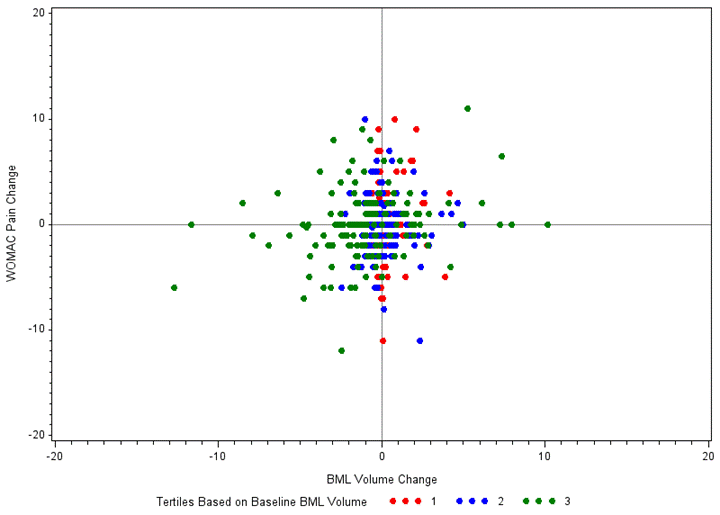Session Information
Session Type: Combined Abstract Sessions
Background/Purpose: Changes in bone marrow lesions (BMLs), common magnetic resonance (MR) imaging findings in osteoarthritis (OA), are predictive of OA progression. However, it is unclear if quantitative measurements of BML volume change are related to knee pain. Therefore, the purpose of this study was to determine whether quantitative measures of BML volume change are positively associated with knee pain change.
Methods: The sample comprised 404 participants in the Osteoarthritis Initiative (OAI) progression cohort who had sagittal intermediate-weighted, turbo spin echo, fat-suppressed MR images at the 24- and 48- month OAI visits. The right knee was assessed unless contraindicated. BML volume was determined on the sagittal fat-suppressed MR images by one rater using a semi-automated segmentation method (ICC [3,1 model] = 0.95). BML volumes were calculated for each knee region and then summed to form a total knee BML volume (cm3). Knee pain was defined based on WOMAC pain score at the 24- and 48-month OAI visits. Multiple linear regressions were used to evaluate the association between the WOMAC pain, as an outcome, and BML volume while controlling for sex, weight, height, and age. To further explore these associations we assessed the associations stratified among tertiles based on baseline BML volume. Based on diagnostic tests (e.g., DFFITs, Cook’s D) for the linear regression models among tertiles we opted to perform robust regression models. WOMAC scores and participant characteristics are available at http://oai.epi-ucsf.org.
Results: The cohort included 199 (49%) females and were 64.9 ± 9.2 years old, 85.3 ± 16.2 kg, and 1.7 ± 0.1 m. The average baseline total knee BML volume was 2.6 ± 2.7 cm3 (range =0.1 to 10.2 cm3). Total knee BML volume change was -0.2 ± 2.1 cm3 (range =-12.7 to 10.2 cm3; see Figure). Larger BML volumes are associated with greater knee pain and larger BML volume changes are associated with worsening knee pain (see Table). Stratified analyses by baseline BML volume (tertiles) indicated that only in the first tertile (no BMLs or BMLs < 1.0 cm3) was BML volume change and WOMAC pain change significantly related (estimate = 0.65, standard error =0.25, p = 0.009).
Conclusion: Change in BML volume is associated with change in knee pain severity. This association may primarily be driven by knees that are progressing from no or small BML volumes to larger BML volumes.
|
Table. Cross-sectional and Longitudinal Association between BML Volume and WOMAC Pain |
|
||
|
Outcome Variable Stratified by Baseline BML Volume Tertile |
Descriptives Mean ± SD |
Models* with Baseline BML Volume B (p-value) |
Models* with BML Volume Change B (p-value) |
|
Full Cohort (n = 404) |
|
|
|
|
WOMAC pain (baseline) |
3.3 ± 3.4 |
0.16 (0.01) |
n/a |
|
WOMAC pain (change) |
0.0 ± 3.0 |
-0.01 (0.87) |
0.21 (0.004) |
|
* All models adjusted for sex, weight, height, and age. SD = standard deviation, BML = bone marrow lesion, B = parameter estimate, n/a = not assessed. |
|||
Figure. Scatter plot of WOMAC Pain Change by BML Volume Change Stratified by Tertiles (colors). Tertiles, based on baseline BML volume, had average baseline total knee BML volumes of 0.6 ± 0.2 cm3, 1.6 ± 0.5 cm3, and 5.5 ± 2.9 cm3; respectively.
Disclosure:
J. B. Driban,
None;
L. L. Price,
None;
G. H. Lo,
None;
J. Pang,
None;
E. Miller,
None;
C. Eaton,
None;
J. A. Lynch,
None;
T. E. McAlindon,
None.
« Back to 2012 ACR/ARHP Annual Meeting
ACR Meeting Abstracts - https://acrabstracts.org/abstract/changes-in-bone-marrow-lesion-volume-relate-to-changes-in-knee-pain-data-from-the-osteoarthritis-initiative/

